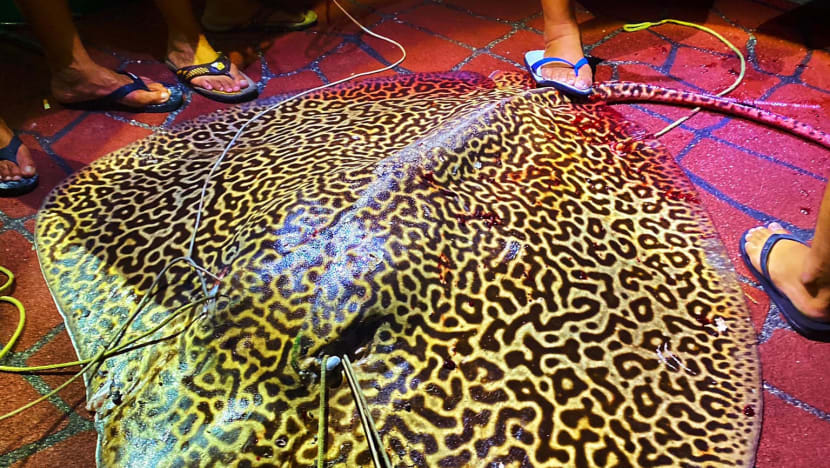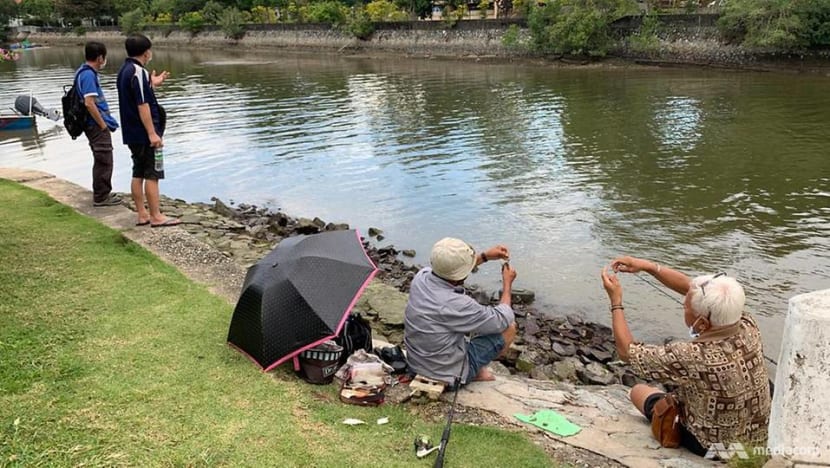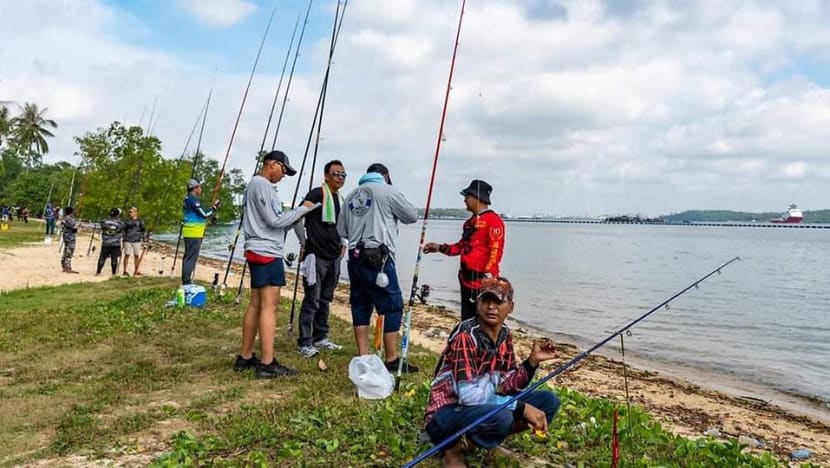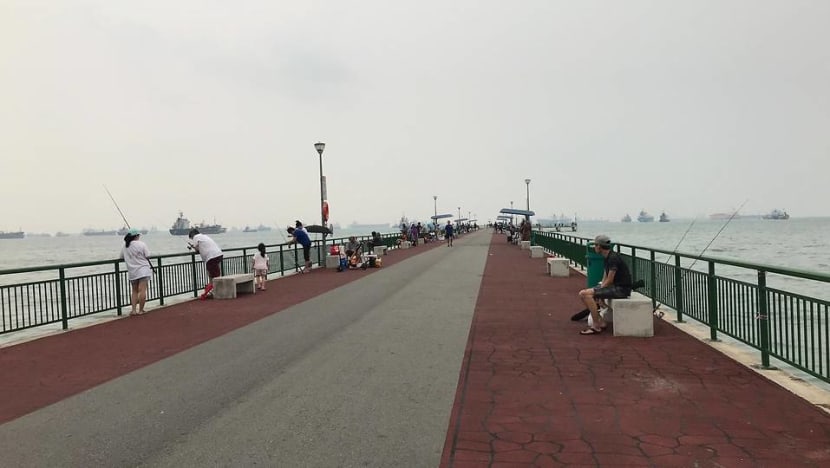Hard to make catch-and-release fishing compulsory, say NParks, anglers after giant ray cut up

Several people are seen fishing in Singapore. (Photo: Lydia Lam)
SINGAPORE: Visit Bedok Jetty in the heart of East Coast Park on any day of the week, and chances are you will find recreational anglers trying to land the biggest catch of their lives.
Some will release anything they catch, as the thrill of their hobby is all about the challenge of hooking a fish and reeling it in, then weighing it and taking a picture.
For others, their catch could end up in the boiling waters of a soup pot, rather than back in the salty ocean waters surrounding Singapore.
The difference in approaches to catching fish was in the spotlight recently after a honeycomb whipray estimated to weigh 80kg was caught at Bedok Jetty on Jul 30 before being cut up and distributed as the makings of a tasty dish.
Several members of the public and the animal welfare group Animal Concerns Research and Education Society said the vulnerable species should have been released.
But the National Parks Board (NParks), anglers and experts told CNA it would be a challenge to make catch-and-release fishing mandatory by law, citing difficulties like enforcement and low survivability among some fish that have been caught.
This is not to say the importance of sustainable fishing is not recognised. Anglers that CNA spoke to said they practise selective catch-and-release fishing, while NParks pointed to several initiatives to educate the community on these measures.
This includes a trial to put up signboards with some form of catch-and-release guidelines at the Changi Boardwalk and Labrador Park, and spreading the word through environmental groups with ties to the fishing community.
Nevertheless, there remains a lack of solid data on how recreational fishing affects marine populations in Singapore, NParks and experts said, adding that studies are ongoing to determine angler habits as well as what and how much they actually catch.

While there are no laws on catch-and-release fishing, the Marine Stewards, a non-profit group promoting sustainable fishing, has worked with anglers and marine researchers to come up with three guidelines supported by NParks.
First, juvenile fish should be released to allow them to grow to maturity and repopulate the sea. The group provides on its website maturity lengths for about 50 species of fish commonly found in Singapore waters, including groupers and snappers.
Second, the critically endangered shovelnose ray, which restaurants usually serve as shark head, should always be released.
Third, anglers should always keep hybrid groupers as these non-native fish can compete with their native counterparts for food and disrupt the local ecosystem.

But the Marine Stewards did not include the honeycomb whipray under its “no take” category. A spokesperson for the group told CNA its “first priority” is to protect species that face the highest level of threat, before looking to others in need of conservation.
The International Union for Conservation of Nature classifies the shovelnose ray as “critically endangered”, two rungs above the “vulnerable” honeycomb whipray.
LEGISLATING CATCH-AND-RELEASE DIFFICULT
The Marine Stewards said it hopes the shovelnose ray will eventually be protected as an endangered species under Singapore law, but admitted that it would take a “very long and involved” process to turn its broader guidelines into legislation.
“So we do what we can as a non-governmental organisation at the ground-up level, to spread the word and educate about sustainable fishing,” it said.

Some jurisdictions have mandated catch-and-release for some types of fish. In Northern Ireland, salmon and sea trout of any size must be released. Anglers are required to pay for a rod licence and fishing permit, and submit a catch return application to tell authorities what they release.
Dr Jeffrey Low, a senior manager at NParks’ coastal and marine branch of the National Biodiversity Centre, said “you need to be very precise with legislation and regulations”.
“The total number of fish species Singapore has is apparently about 800,” he said in an interview with CNA. “Even if say, one-third of that is fished by the anglers, then how are you going to legislate for every single fish?”
READ: IN FOCUS: How urbanised Singapore is learning to live with its wildlife
Other factors that could make legislation challenging, Dr Low said, include whether a fish had swallowed a hook and is still alive when caught. Anglers said fish must be de-hooked and carried to shore before being released. Some are close to death even before that.
Enforcement would also have to cover numerous fishing spots in Singapore on top of those who go out to sea by boat, Dr Low said, adding that fishing can take place day and night.
“It means someone needs to be at the marina 24/7, it can be quite challenging,” he stated.

Dr Zeehan Jaafar, who studies marine ecosystems at the National University of Singapore, said the Marine Stewards guidelines are a “good first pass” in the absence of legislation.
“While best practices can be adopted, factors such as species, physiology and anatomy of the fishes are important in the final outcome,” she added.
“Studies show that some species exhibit high mortality after being released even when best practices are in place.”
READ: PUB releases thousands of fish in Pandan Reservoir to combat midges
Dr Neil Hutchinson, a fisheries expert at James Cook University Singapore, said any legislation should be science-based and developed with research scientists.
“What cannot be overemphasised would be the need for investment in a number of areas such as policing of guidelines,” he added.
“For example, in many Australian states there are active fisheries officers who check people’s catches, and fishers breaking the rules can be on the receiving end of some hefty penalties.”
Singapore does not have such a system, Dr Low acknowledged, stating that NParks has opted for a softer, ground-up approach instead.
“(This) is why we're taking the community approach, because everybody talks to each other and generally by consensus agrees that these are some of the best practices,” he added. “I think that for us might be an easier approach.”
MORE RESEARCH NEEDED
In any case, NParks and experts agreed that guidelines and legislation should be based on scientific studies that determine the impact of recreational fishing on fish populations. Dr Low said there have only been anecdotal accounts of dwindling stocks in fishing spots.
To that end, Dr Low is involved in a number of research projects with several universities to better understand the impact. This includes studying past catches and how big these fishes are, as well as interviewing anglers on their fishing habits.
“We're in the process of trying to analyse all that data; it's quite a large data set and it’s hard to analyse so we haven't come up with any concrete outcomes yet,” he said.
“We don’t even know how much (anglers) catch, to be honest. So to say there is a sufficient impact to the environment is perhaps jumping the gun a little bit.”

Dr Hutchinson said “we simply don’t know the extent to which different species are being fished, how healthy local populations are, or indeed the basic ecology of many of these fish species”.
“There is also a real need to develop tools such as stock assessments of key species to enable some form of management moving forward based on future research findings,” he said.
READ: Overfishing on the rise as global consumption climbs: UN food agency
Despite that, Dr Hutchinson said research elsewhere has shown that recreational fishing can have an impact on local fish stocks, stressing the need to conduct more research in this field locally and “act accordingly”.
In the absence of large-scale commercial fishing in Singapore, the Marine Stewards said most of the country’s fishing pressure comes from recreational fishing, with every angler playing a part.
“If one angler chooses to release 500g of fish every two weeks, multiplied by 1,000 anglers, that amounts to one ton of fish per month, or 12 tons a year,” the group said. “These fish get to grow big and spawn, so there is a multiplier effect.”
SOME ANGLERS CATCH AND RELEASE
Angler Mr Muhammad Iskandar Samri understands this, telling CNA that he releases juveniles and only keeps plate-sized catch to distribute to friends and family for food.
“It’s healthy for the ecosystem and it’s healthy for us as we can keep going fishing,” said the 36-year-old who fishes twice a week. “The fish can grow, breed and attract other fishes to come in.”

But Mr Iskandar, who works in the service line at the airport, acknowledged that some anglers keep even small fish, adding that this practice is frowned upon in his fishing circles.
“An individual can influence other people in the group, and if they think that (catch-an–release) is a better practice, they will follow,” Mr Iskandar said.
“For some, they will just bring back everything, whether they eat the fish or not. If it goes to the waste, we have no idea.”
Another angler Mr Muhammad Hairul Ibrahim, 39, explained that those who keep everything see their catch as a “gift” borne from their hard work and years of fishing. “It’s like a prize trophy,” he said.
READ: PUB removes 140 stingrays from Lower Peirce Reservoir, reopens fishing grounds
Fellow angler Mr Amirul Kurniawan, 27, knows what this kind of practice could lead to.
He was fishing near Changi Beach when he showed CNA two small fish that anglers had probably left on the rocks to die. He put them under a bench and said he would later properly dispose of them.
“It is up to individual preference, how their mentality is,” he said.
NParks’ Dr Low said this is why it is important to work with the Marine Stewards and other groups with access to the larger angler community to educate them on sustainable fishing.
“Maybe the target audience that we should focus on is the seasoned but slightly younger group,” he said. “Because this new group will have no traditions, so it's easier to instill some of these habits in them.”
Involving the community would also ensure that if Singapore ever turned to legislation, it would be something that is accepted by various stakeholders, “as opposed to something that is imposed”, Dr Low added.
PROS AND CONS OF LEGISLATION
But Mr Iskandar said he was against legislation, noting that many anglers already fish responsibly by going to legal spots, keeping the place clean and releasing their catch where possible.
The added cost would not make the hobby worth it, said Mr Amirul.
“Laws will definitely make things difficult because in Singapore the catching rate is already very low,” said Mr Iskandar. “Then you have to spend money on a licence and put people on enforcement. For me it’s not the way to go.”

On the other hand, angler Mr Ng Jia An, 30, said the regulation of recreational fishing could benefit the community in the long run.
The money from licence applications could be used to develop the industry, he said, with better facilities for anglers and opportunities to improve their skills. Authorities could also release more fish at spots where anglers report low catch rates, he added, citing the example of Australia.
“It could develop this sport to a higher level,” said Mr Ng, who has worked in the fishing industry for 10 years and was most recently a guide at a sport fishing company based in Papua New Guinea.
“It would benefit the average fishing catch rate, the environment or even tourism as a whole. We actually enjoy a fair bit of tourists coming into Singapore ... who do a bit of fishing for a couple of days. And I believe there’s a big industry for it.”
COMBINATION OF KEEP AND RELEASE THE WAY TO GO
Nevertheless Mr Ng, who practises catch-and-release unless friends make special requests for certain types of fish for food, said the trend is shifting towards sustainable fishing.
“If you were to be fishing 10 years ago, catch-and-release is very rarely heard of. But in recent years, it has been widely promoted,” he said.
“There are a lot of guys on the ground showing anglers how to release fish the right way, what equipment you should use to cause less damage and stress.
“We have to make it clear that if we are promoting it as a sport, this is the encouraged way. But again, you still can go fishing, catch a fish and enjoy it for dinner. It’s all about co-existing together.”

The Marine Stewards acknowledged that Singapore started out as a fishing village, with fishing becoming an important part of its history and culture.
“It is okay to catch a fish to eat,” the group said.
“In fact, when you catch a fish with rod and line, that is probably a more sustainable way of catching fish compared to some of the fish that you get at the market that might have been caught by large nets.”
READ: Singapore fishery ports to be consolidated amid review of fresh food wholesale industry
The angler Mr Amirul, who fishes every weekend, only keeps mature fish that he knows will taste good, like snapper and catfish. The latter makes for a good asam pedas dish, he said.
“In Singapore, it’s not really easy to catch desired or good-sized fish unless you take a boat out to sea,” he said. “If you try hard and something bites that is of a good size, that’s your reward. I’m happy to bring it home.”














